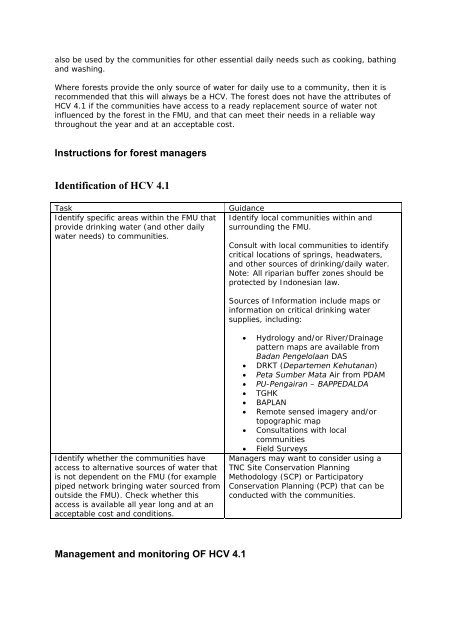English - HCV Resource Network
English - HCV Resource Network
English - HCV Resource Network
You also want an ePaper? Increase the reach of your titles
YUMPU automatically turns print PDFs into web optimized ePapers that Google loves.
also be used by the communities for other essential daily needs such as cooking, bathing<br />
and washing.<br />
Where forests provide the only source of water for daily use to a community, then it is<br />
recommended that this will always be a <strong>HCV</strong>. The forest does not have the attributes of<br />
<strong>HCV</strong> 4.1 if the communities have access to a ready replacement source of water not<br />
influenced by the forest in the FMU, and that can meet their needs in a reliable way<br />
throughout the year and at an acceptable cost.<br />
Instructions for forest managers<br />
Identification of <strong>HCV</strong> 4.1<br />
Task<br />
Identify specific areas within the FMU that<br />
provide drinking water (and other daily<br />
water needs) to communities.<br />
Guidance<br />
Identify local communities within and<br />
surrounding the FMU.<br />
Consult with local communities to identify<br />
critical locations of springs, headwaters,<br />
and other sources of drinking/daily water.<br />
Note: All riparian buffer zones should be<br />
protected by Indonesian law.<br />
Sources of Information include maps or<br />
information on critical drinking water<br />
supplies, including:<br />
Identify whether the communities have<br />
access to alternative sources of water that<br />
is not dependent on the FMU (for example<br />
piped network bringing water sourced from<br />
outside the FMU). Check whether this<br />
access is available all year long and at an<br />
acceptable cost and conditions.<br />
• Hydrology and/or River/Drainage<br />
pattern maps are available from<br />
Badan Pengelolaan DAS<br />
• DRKT (Departemen Kehutanan)<br />
• Peta Sumber Mata Air from PDAM<br />
• PU-Pengairan – BAPPEDALDA<br />
• TGHK<br />
• BAPLAN<br />
• Remote sensed imagery and/or<br />
topographic map<br />
• Consultations with local<br />
communities<br />
• Field Surveys<br />
Managers may want to consider using a<br />
TNC Site Conservation Planning<br />
Methodology (SCP) or Participatory<br />
Conservation Planning (PCP) that can be<br />
conducted with the communities.<br />
Management and monitoring OF <strong>HCV</strong> 4.1

















